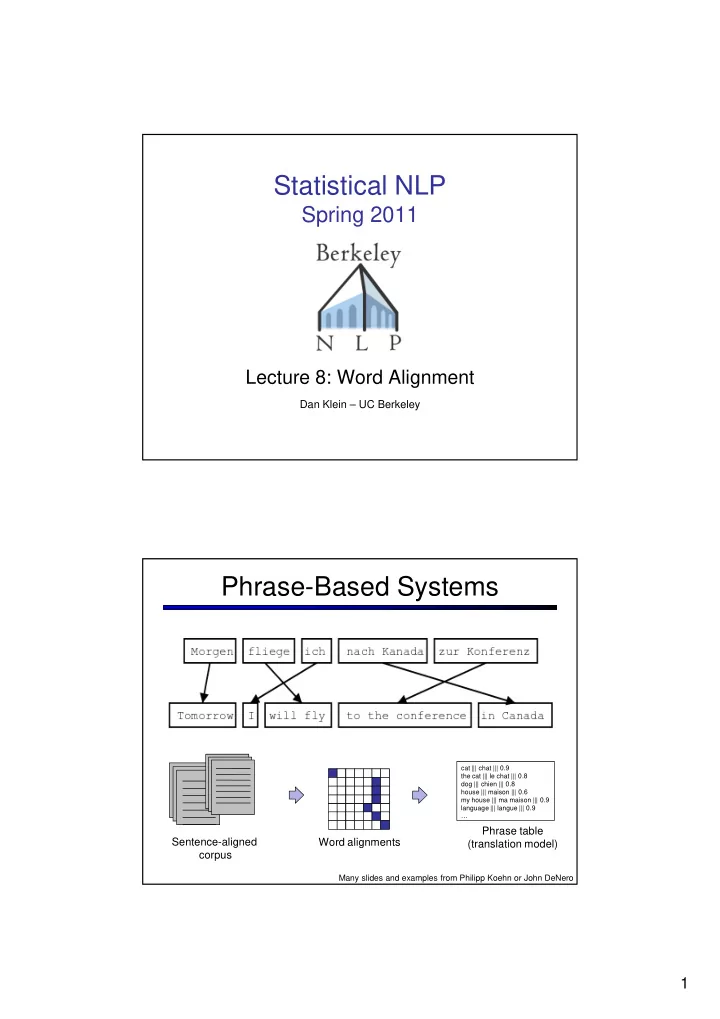

Statistical NLP Spring 2011 Lecture 8: Word Alignment Dan Klein – UC Berkeley Phrase-Based Systems cat ||| chat ||| 0.9 the cat ||| le chat ||| 0.8 dog ||| chien ||| 0.8 house ||| maison ||| 0.6 my house ||| ma maison ||| 0.9 language ||| langue ||| 0.9 … Phrase table Sentence-aligned Word alignments (translation model) corpus Many slides and examples from Philipp Koehn or John DeNero 1
The Pharaoh “Model” [Koehn et al, 2003] Segmentation Translation Distortion Phrase-Based Decoding 2
Phrase Translation � If monotonic, almost an HMM; technically a semi-HMM for (fPosition in 1…|f|) for (lastPosition < fPosition) for (eContext in eContexts) for (eOption in translations[fPosition]) … combine hypothesis for (lastPosition ending in eContext) with eOption � If distortion… now what? Non-Monotonic Phrasal MT 3
Pruning: Beams + Forward Costs � Problem: easy partial analyses are cheaper � Solution 1: use beams per foreign subset � Solution 2: estimate forward costs (A*-like) The Pharaoh Decoder 4
Hypotheis Lattices Word Alignment 5
Word Alignment ��� � � ������ �� ��� ���� ���������� ������������������������ ��� ������������ ��� ������������������������ �� ����������� ����������������������� ����� ���� ���� �� ��� ����������� ����������������������� ����� ����� ������ �������������������������� ������ ��� ������������������������� ���� ����������� ���� ����������� ��� �������� ���� � ������ � Unsupervised Word Alignment Input: a bitext : pairs of translated sentences � nous acceptons votre opinion . we accept your view . Output: alignments : pairs of � translated words � When words have unique sources, can represent as a (forward) alignment function a from French to English positions 6
1-to-Many Alignments IBM Model 1 (Brown 93) Alignments: a hidden vector called an alignment specifies which � English source is responsible for each French target word. 7
IBM Models 1/2 1 2 3 4 5 6 7 8 9 E : Thank you , I shall do so gladly . A : 1 3 7 6 8 8 8 8 9 F : Gracias , lo haré de muy buen grado . Model Parameters Emissions: P( F 1 = Gracias | E A1 = Thank ) Transitions : P( A 2 = 3) Evaluating TMs � How do we measure quality of a word-to-word model? � Method 1: use in an end-to-end translation system � Hard to measure translation quality � Option: human judges � Option: reference translations (NIST, BLEU) � Option: combinations (HTER) � Actually, no one uses word-to-word models alone as TMs � Method 2: measure quality of the alignments produced � Easy to measure � Hard to know what the gold alignments should be � Often does not correlate well with translation quality (like perplexity in LMs) 8
Alignment Error Rate � Alignment Error Rate ����������� � ��������������� � ��� ���������������� Problems with Model 1 � There’s a reason they designed models 2-5! � Problems: alignments jump around, align everything to rare words � Experimental setup: � Training data: 1.1M sentences of French-English text, Canadian Hansards � Evaluation metric: alignment error Rate (AER) � Evaluation data: 447 hand- aligned sentences 9
Intersected Model 1 � Post-intersection: standard practice to train models in each direction then intersect their predictions [Och and Ney, 03] � Second model is basically a filter on the first � Precision jumps, recall drops � End up not guessing hard alignments Model P/R AER Model 1 E → F 82/58 30.6 Model 1 F → E 85/58 28.7 Model 1 AND 96/46 34.8 Joint Training? � Overall: � Similar high precision to post-intersection � But recall is much higher � More confident about positing non-null alignments Model P/R AER Model 1 E → F 82/58 30.6 Model 1 F → E 85/58 28.7 Model 1 AND 96/46 34.8 Model 1 INT 93/69 19.5 10
Monotonic Translation Japan shaken by two new quakes Le Japon secoué par deux nouveaux séismes Local Order Change Japan is at the junction of four tectonic plates Le Japon est au confluent de quatre plaques tectoniques 11
IBM Model 2 � Alignments tend to the diagonal (broadly at least) � Other schemes for biasing alignments towards the diagonal: � Relative vs absolute alignment � Asymmetric distances � Learning a full multinomial over distances EM for Models 1/2 � Model 1 Parameters: Translation probabilities (1+2) Distortion parameters (2 only) � Start with uniform, including � For each sentence: � For each French position j � Calculate posterior over English positions � (or just use best single alignment) � Increment count of word f j with word e i by these amounts � Also re-estimate distortion probabilities for model 2 � Iterate until convergence 12
Example Phrase Movement On Tuesday Nov. 4, earthquakes rocked Japan once again Des tremblements de terre ont à nouveau touché le Japon jeudi 4 novembre. 13
The HMM Model 1 2 3 4 5 6 7 8 9 E : Thank you , I shall do so gladly . A : 1 3 7 6 8 8 8 8 9 F : Gracias , lo haré de muy buen grado . Model Parameters Emissions: P( F 1 = Gracias | E A1 = Thank ) Transitions : P( A 2 = 3 | A 1 = 1) The HMM Model � Model 2 preferred global monotonicity � We want local monotonicity: � Most jumps are small � HMM model (Vogel 96) -2 -1 0 1 2 3 � Re-estimate using the forward-backward algorithm � Handling nulls requires some care � What are we still missing? 14
HMM Examples AER for HMMs Model AER Model 1 INT 19.5 HMM E → F 11.4 HMM F → E 10.8 HMM AND 7.1 HMM INT 4.7 GIZA M4 AND 6.9 15
Recommend
More recommend